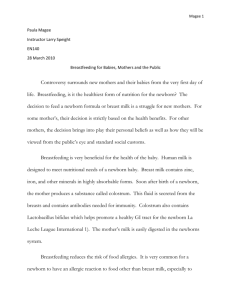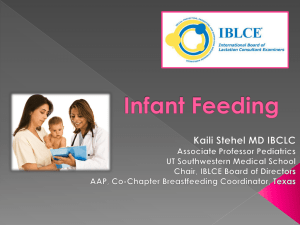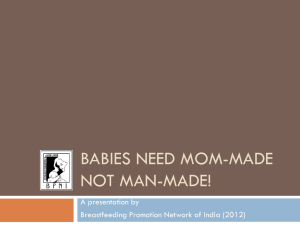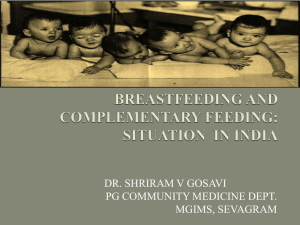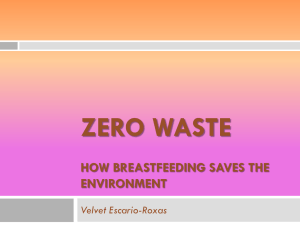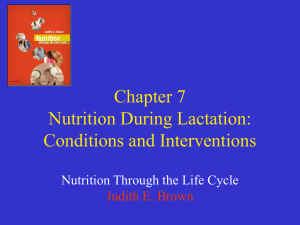Medical Nutrition Therapy for Women with Preexisting Diabetes
advertisement
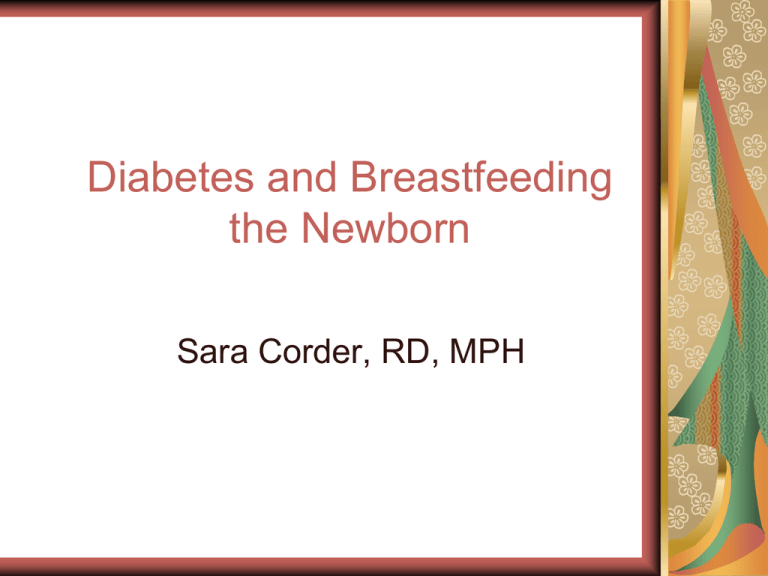
Diabetes and Breastfeeding the Newborn Sara Corder, RD, MPH Breastfeeding Trivia “If all babies were breastfed exclusively for their first six months of life and then given nutritious complementary food with continued breastfeeding up to two years of age, the lives of an additional ________ children under five would be saved every year.” Dr Elizabeth Mason, Director of WHO's Department of Maternal, Newborn, Child and Adolescent Health and Development American Academy of Pediatrics Human milk is the preferred feeding for all infants, including premature and sick newborns, with rare exceptions. Exclusive breastfeeding for the first six months and support for breastfeeding for the first year and beyond as long as mutually desired by mother and child. The World Health Organization Recommends continued breastfeeding up to 2 years of age or beyond. Antiallergenic Factors Antiparasitic Factors Antiviral Factors Antibacterial Factors Hormones Growth Factors Enzymes Fatty Acids: DHA / ARA Fatty Acids: DHA / ARA Minerals Minerals Vitamins Vitamins Fats Fats Carbohydrates Carbohydrates Protein Protein Water Water Human Milk Is Adaptable!! During a feeding, breast milk changes from low fat to higher fat. In cold climates breast milk has increased fat for energy, in hot climates, more water to prevent dehydration. During gradual weaning, breast milk volume decreases, but the antibodies in the milk increase. Mothers of premature babies make milk that is higher in growth factors, protein and fats. Mothers who are malnourished produce slightly less milk, but the milk is equal in fat, protein and carbohydrate. Benefits of BreastfeedingTip of the Iceberg Mother Enhances bonding Mobilizes fat store Reduce risk of premenopausal breast/ovarian caner Protective role against chronic diseases HDL increased Economical No preparation Infant Enhances bonding Reduce incidence/severity ear infections Reduces incidence of respiratory infections Decrease risk tooth decay Reduces incidence of diarrhea Reduces risk of obesity Reduces risk of SIDS Breastfeeding & Diabetes Why is breastfeeding particularly good for the mother with DM and particularly good for the infant from a mother with Diabetes? (IDM) Good for the Mother Improved Glucose Metabolism Non-insulin mediated use of glucose by mammary gland to synthesize lactose. Increased insulin sensitivity due to increased prolactin and decreased estradial Improved B cell function with 3 months of breastfeeding in women with GDM Good for the Mother Improved Lipid Metabolism Women who have breastfeed for at least 3 months LDL levels increase less HDL levels decrease less Good for the Mother Improved Weight Loss Prospective studies using measured weight change reported lower postpartum weight retention in lactating women Rate of metabolic syndrome is sig lower with increasing lifetime duration of breastfeeding Good for the Mother Lower rate of DM2 in Women who lactated Duration of lactation inversely associated with risk of DM2 in young and middle aged women Non-lactating women developed DM2 at a 2 fold higher rate than lactating women after GDM. Good for the IDM Breastfed Infants are Leaner Inverse relationship between breastfeeding and development of obesity Formula fed infants produce more insulin Hyperinsulinemia retards lipolysis and enhances fat deposit. Good for the IDM Less Overfeeding: changes in breast milk composition during feeding provide satiety signals to the infant Breast milk contains leptin- early leptin intake can influence later eating behavior. Fetal Origins of Adult Disease The b-cells of the fetal pancreas become more responsive to glucose late in gestation and b-cell mass increase in the last trimester of pregnancy Theory:A high availability of glucose programs pancreatic islet development irreversibly influencing the metabolic response to glucose later in life and predisposing to certain patterns of adult disease. What is newborn Hypoglycemia? Refers to a reduction in the glucose concentration of circulating blood. Still controversialno consensus on cut off values (30-50mg/dL) Avoiding Newborn Hypoglycemia in the IDM Achieve normoglycemia during pregnancy and LABOR Terbutaline and ephedrine can cause maternal hyperglycemia and subsequent fetal hyperinsulinemia. Avoiding Newborn Hypoglycemia Breastfeed Immediately or within 30 minutes after birth, 10-12x/24hr Cold wet babies use more glucose- Dry thoroughly and place skin to skin ASAP Encourage frequent feeds until BG > 45mg/dL BEFORE feedings. Monitor infant BG for at least 24hrs or until stable for at least 3 consecutive feedings. Medically Necessary Separation Provide EXTRA Support for establishing breastfeeding Use Pump within first 12 hrs Modern Pumps Are Amazing! Avoiding Maternal Hypoglycemia Glucose preferentially shunted towards production of milk DM1(rarely DM2) prone to hypoglycemia especially at night May have to adjust evening dose of basal insulin- Bedtime Snack Necessary Avoiding Maternal Hypoglycemia If BG <100 BEFORE feeding take 15g CHO and 7 g protein. If BG < 100 AFTER feeding consider 15 g snack if insulin on board. Hypoglycemia causes release of epinephrine which can cause temporary decrease in milk production. Healthy Eating During Lactation No surprises- Follow GDM meal plan! May add fruit/milk at breakfast May add cereal to breakfast May add: 2 fat servings, 1 fruit and 1 starch to support extra calorie needs during breastfeeding Drink Plenty of WATER Avoid Juices and Sweetened Drinks Challenges to Breastfeeding Women with DM less likely to breastfeed Difficult labor Obesity interfering with body mechanics Fear of giving diabetes through breast Need to continue insulin and “tight” control of BG Lack of support Lack of Societal Acceptance Societal Barriers What would happen to this mother in the USA? Best for Babeswww.BestforBabes.org Endorsed by American Academy of Pediatrics Give breastfeeding a makeover Market it, Brand it, Mainstream it Foster a cultural change Using positive social pressure stemming from the power of celebrities, foundations, fashion, advertising, the medical community and the media Identify barriers At home, in public and workplace Breaking Societal Barriers….? A Start… New Look of Breastfeeding New Look of Breastfeeding New Look of Breastfeeding New Look of Breastfeeding Gabrielle Reece “Quite frankly I sort of thought, oh god, if I can get through these six months, because I was really committed to the health idea, and then it turned out that I breastfed my first child for 23 months.” Jenna Elfman If I was on a plane, I would just say to the person next to me, “I have to feed my kid because I want his ears to pop, so if you don’t like it, look the other way.” Salma Hayek "her left breast has now done more for humanity in a few minutes than I've done in roughly my life.“ Breastfeeding Supporter DEBATE “The debate is over, the science of breastfeeding is strong, now…how do we help moms get it done?” “As physicians, many of us have a lot to learn about business, marketing ourselves, marketing our product and our passion.”
